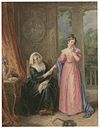Bed trick
Thebed trickis a plot device in traditional literature and folklore; it involves a substitution of one partner in the sex act with a third person (in the words ofWendy Doniger,"going to bed with someone whom you mistake for someone else" ). In the standard and most common form of the bed trick, a man goes to a sexual assignation with a certain woman, and without his knowledge that woman's place is taken by a substitute.
In traditional literature
[edit]Instances of the bed trick exist in the traditional literatures of many human cultures.[1]It can be found in theOld Testament:inGenesisChapter 29LabansubstitutesLeahforRachelonJacob's wedding night, as Jacob discovers the following morning. Other examples range throughout the Western canon (several occur inArthurian romance,as well as in Chaucer's "The Reeve's Tale") and can be paralleled by instances in non-Western cultures (such as that ofIndraandAhalyain the ancient Indian epicRamayana).[2][3]
Renaissance
[edit]For modern readers and audiences, the bed trick is most immediately and most closely associated withEnglish Renaissance drama,[4]primarily due to the uses of the bed trick byShakespearein his two dark comedies,All's Well That Ends WellandMeasure for Measure.InAll's Well That Ends Well,Bertram thinks he is going to have sex with Diana, the woman he is trying to seduce; Helena, the protagonist, takes Diana's place in the darkened bedchamber, and so consummates their arranged marriage. In this case, the bed trick derives from Shakespeare's non-dramatic plot source, the ninth story of the third day in theDecameronofBoccaccio(which Shakespeare may have accessed through an English-language intermediary, the version inWilliam Painter'sPalace of Pleasure).[5]InMeasure for Measure,Angelo expects to have sex with Isabella, the heroine; but the Duke substitutes Mariana, the woman Angelo had engaged to marry but abandoned. In this case the bed trick was not present in Shakespeare's sources, but was added to the plot by the poet.[6]
(Related plot elements can be found in two other Shakespearean plays. In the final scene ofMuch Ado About Nothing,the bride at Claudio's wedding turns out to be Hero instead of her cousin, as expected; and inThe Two Noble Kinsmen,the Wooer pretends to be Palamon to sleep with and marry the Jailer's Daughter.)
The two uses of the bed trick by Shakespeare are the most famous in the drama of his era; they were emulated by more than forty other uses, however, and virtually every major successor of Shakespeare down to the closing of the theatres in 1642 employed the plot element at least once.[7]The use of the bed trick inMiddletonandRowley'sThe Changeling,in which Diaphanta takes Beatrice-Joanna's place on the latter's wedding night, is probably the most famous instance outside of Shakespeare. Rowley also provides a gender-reversed instance of the bed trick in hisAll's Lost by Lust,in which it is the male rather than the female partner in the sexual pair who is substituted. (Male versions of the bed trick are rarer but not unprecedented; a classical instance occurs whenZeusdisguises himself asAmphitryonto impregnateAlcmenewith the futureHercules.Similarly in Arthurian legend,Uther Pendragontakes the place ofGorloisto impregnateIgrainewith the futureKing Arthur.)
Multiple uses of the bed trick occur in the works of Thomas Middleton,John Marston,John Fletcher,James Shirley,Richard Brome,andThomas Heywood.[8]Shakespeare employs the bed trick to yield plot resolutions that largely conform to traditional morality, as do some of his contemporaries; in the comic subplot toThe Insatiate Countess(c. 1610), Marston constructs a double bed trick in which two would-be adulterers sleep with their own wives. Shakespeare's successors, however, tend to use the trick in more sensational and salacious ways. In Rowley's play cited above, it leads to the mistaken murder of the substituted man. Middleton'sHengist, King of Kentfeatures an extreme version of the bed trick, in which a woman is kidnapped and raped in darkness, by a man she doesn't realise is her own husband.
Post-Renaissance
[edit]After theatres re-opened with the start of theRestorationera, the bed trick made sporadic appearances in plays byElkanah SettleandAphra Behn,[9]and perhaps reached its culmination in SirFrancis Fane'sLove in the Dark(1675); but in time it passed out of fashion in drama.
Modern critics, readers, and audience members tend to find the bed trick highly artificial and lacking in credibility (though scholar Marliss Desens cites one alleged real-life instance of its employment in Shakespeare's era).[10]In contemporary legal systems the bed trick may be considered a form ofrape by deception.
Some other bed-trick plays
[edit]
|
In other media
[edit]InRichard Strauss's 1932 operaArabella,Zdenka/Zdenko, the daughter consigned to live as a boy because of family finances, contrives to pretend she is her sister Arabella to sleep with Matteo, with whom she is secretly in love.
The bed trick can be seen inEliza Haywood's novelLove in Excess.
The bed trick is used inRoald Dahl's storyThe Great Switcheroo.
A variation of the bed trick can also be seen in the movieRevenge of the Nerds.
TheFamily Guyepisode "Peter-assment" features a farcical and unwieldy variation, with Peter hiding Quagmire and Mort under his clothes to have sex with his Boss Angela.
The bed trick is also used twice in the filmThe Rocky Horror Picture Show.
References
[edit]- ^Wendy Doniger,The Bedtrick: Tales of Sex and Masquerade,Chicago, University of Chicago Press, 2000.
- ^Geert Jan Van Gelder,Close Relationships: Incest and Inbreeding in Classical Arabic Literature,New York, I. B. Tauris, 2005; pp. 145–6 and ff.
- ^Doniger, Wendy (2022).The Bedtrick: Tales of Sex and Masquerade.University of Chicago Press.p. 56.ISBN978-0-226-15644-6.
- ^Marliss C. Desens,The Bed-Trick in English Renaissance Drama: Explorations in Gender, Sexuality, and Power,Dover, DE, University of Delaware Press, 1994.
- ^Anne Barton, Introduction toAll's Well That Ends Well,in:The Riverside Shakespeare,G. Blakemore Evans, general editor; Boston, Houghton Mifflin, 1974; pp. 499–500.
- ^Anne Barton, Introduction toMeasure for Measure,in:The Riverside Shakespeare,pp. 545–6.
- ^William R. Bowden, "The Bed Trick, 1603–1642: Its Mechanics, Ethics, and Effects,"Shakespeare Studies5 (1969), pp. 12–23.
- ^Desens, p. 11 and ff.
- ^Nancy Copeland,Staging Gender in Behn and Centlivre: Women's Comedy and the Theatre,London, Ashgate, 2004; pp. 43, 71–6.
- ^Desens, p. 13.


